Physical Address
304 North Cardinal St.
Dorchester Center, MA 02124
Abnormalities of the urinary tract are relatively common, accounting for approximately 20% of all fetal malformations. The exact incidence of prenatally detected urinary tract anomalies is difficult to determine and varies from centre to centre and with the timing of the ultrasound examination.
Although advances in ultrasound machine technology have meant that the diagnosis of renal disease is more accurate, there remains a significant false-positive rate, which ranges between 39% and 52%. This high false-positive rate is mainly due to the detection of mild hydronephrosis, which is subsequently found to be normal after birth. This problem is slowly being resolved but, to date, there is still debate as to the degree of dilatation seen on antenatal ultrasound that should prompt full postnatal investigation. The majority of renal abnormalities are not life-threatening. However, severe bilateral renal abnormalities account for 10% of all terminations for lethal fetal abnormalities.
The detection and management of prenatally detected urinary tract anomalies are therefore still open to discussion and it is the increasing move towards a multidisciplinary approach with obstetricians, radiologists and paediatric nephrologists/urologists in close communication which will improve the management of such fetuses.
The cranial end of the nephrogenic cord develops into the pro- and mesonephros both of which are drained by the mesonephric duct. In the 4th week of gestation the pronephros (the primitive precursor of the kidney) first appears but soon regresses. The upper urinary tract derives from the cervical portions of the paired blocks of the mesoderm. The mesonephros from the midzone differentiates into tubular structures which have an initial excretory function and eventually form the gonads ( Figures 18-1 and 18-2 ).
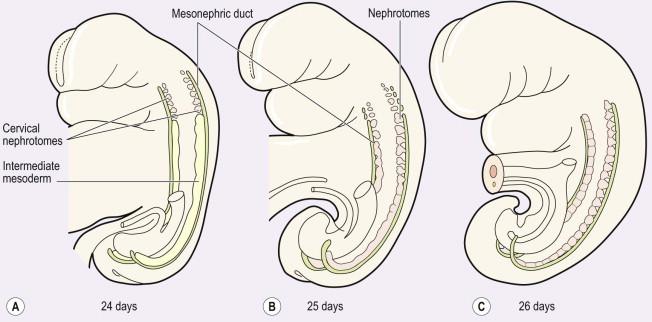
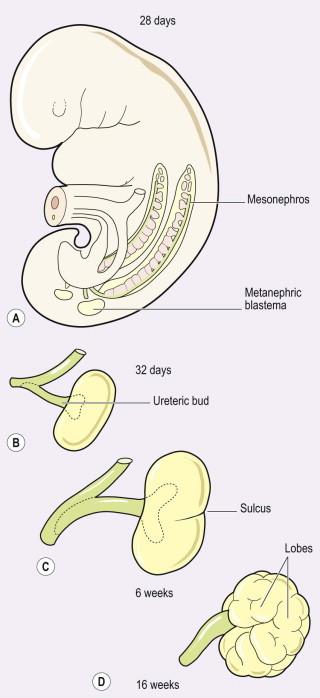
The mesonephric or Wolffian ducts develop lateral to the mesoderm. They fuse caudally with the ventral wall of the primitive cloaca, the urogenital sinus which later becomes the bladder and urethra ( Figure 18-3 ). The mesonephric duct and the ureter eventually open separately with the ureter opening cranial and lateral to the opening of the mesonephric duct. The ducts canalize and in the male the mesonephric duct later differentiates into the epidymis, vas deferens and ejaculatory duct. It degenerates in the female. In the female the paramesonephric or Mullerian duct grows alongside the mesonephric duct. This duct, which degenerates in the male, gives rise to the fallopian tubes, uterus and superior part of the vagina. In the female, the primitive gonad forms the ovary and the mesonephric duct regresses.
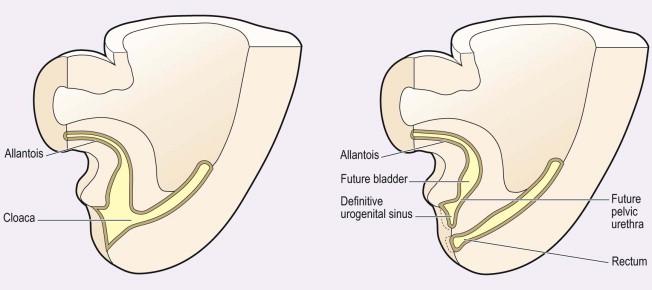
At the 5th week the tubular outgrowths called the ureteric buds arise from the caudal end of the mesonephric duct near its point of entry into the cloaca and grow into a mass of undifferentiated mesodermal cells called the metanephric blastema and form the metanephros. At 32 weeks the bud fuses with the metanephros and this initiates nephrogenesis. The appearance of the ureteric buds occurs at the same time as the division of the cloaca into the anterior urogenital sinus and the posterior anal canal.
The kidneys remain retroperitoneal during development, but ascend between 6–10 weeks from an initial sacral position to between the 12th thoracic and 3rd lumbar vertebrae ( Figure 18-4 ). The lobulated embryonic kidneys ascend up the post-abdominal wall to their lumbar position with blood supply derived from increasingly higher levels of the aorta during ascent. Ureteric bud derivatives give rise to renal pelvis, calyces major and minor and collecting ducts. The hilum is initially anterior but rotates to an eventual more medial position. The metanephric mesenchyme gives rise to the glomerulus, collecting tubules and loop of Henle.
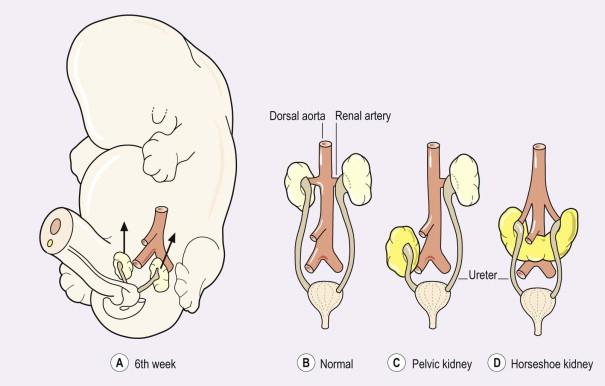
Urine production starts in the 10th week when there is continuation between distal convoluted tubules and collecting ducts. The ureteric bud derivatives stop proliferating at 15 weeks but new generations of nephrons appear until 36 weeks. Nephrogenesis ceases at 36 weeks and the number of nephrons is fixed for life. There are on average 700,000 nephrons per kidney. The lobulated appearance of the developing kidney usually becomes smooth in the first year of life. This fetal lobulation can however persist for many years.
The early development of the external genitalia is similar in males and females. In the 5th week a pair of swellings, called the cloacal folds, develops on either side of the cloacal membrane. These folds meet anteriorly to form the genital tubercle ( Figure 18-5 ). During the 7th week the cloacal folds meet posteriorly to form the urogenital fold anteriorly and the anal fold posteriorly. The urogenital membrane breaks down late in the 7th week and this will become the vestibule of the vagina in the female and the urethra in the male ( Figure 18-6 ). The appearance of the external genitalia is similar up to the 12th week. After this time, in males the urogenital fold and genital tubercle lengthen to form the penis and there is fusion of the urogenital membrane to form the urethra. In females the genital tubercle bends inferiorly to form the clitoris and the urogenital sinus becomes the vestibule of the vagina.
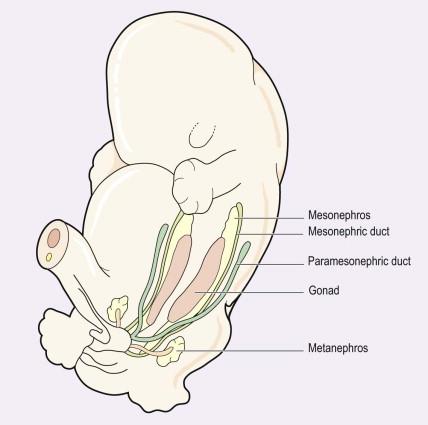
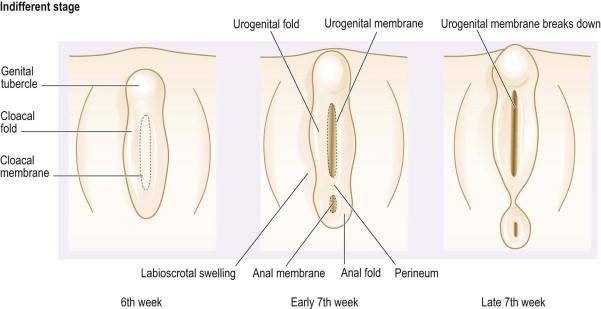
Examination of the kidneys (in transverse and longitudinal planes), forms part of the routine sonographic assessment of the fetal anatomy. The fetal kidneys are identifiable on a transabdominal scan by 11 to 12 weeks' gestation when they appear as two oval hyperechogenic structures on either side of the spine ( Figure 18-7 ). Between 18 and 24 weeks' gestation, the echogenic renal cortex is distinguishable from the hypoechogenic medulla and the sonolucent pelvis can be readily vizualized ( Figure 18-8 ). With modern scanning equipment the hypo-echoic pyramids will be vizualized and must not be mistaken for renal cysts. The adrenal glands characteristically appear as triangular multi-layered structures outlining the upper poles of both kidneys. The kidneys, including the renal pelvis, enlarge with advancing gestational age and can be evaluated in a quantitative manner ( Figure 18-9 A and B ). The fetal ureters are normally not visible, however in very slim pregnant individuals they may be seen and should not measure more than 1–2 mm ( Figure 18-10 A and B ). The fetal bladder can be identified from 11–12 weeks' gestation and inability to visualize it can be considered as abnormal from 15 weeks onwards. Serial examinations may be required to identify the bladder, since the fetus voids about every 60 minutes ( Figure 18-11 ). The bladder wall thickness is best assessed at the level of the vesical artery and the wall thickness should be no more than 2 mm.
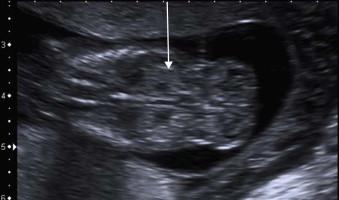
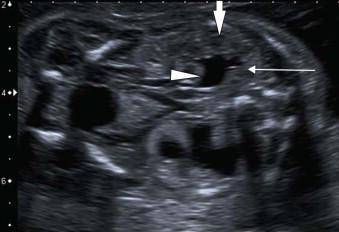
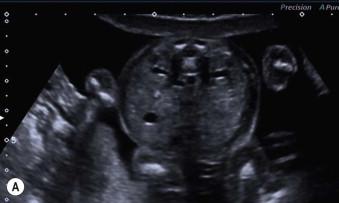

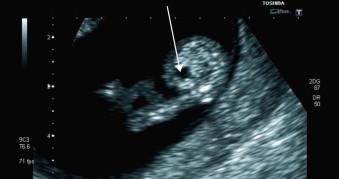
The fetal kidneys start to produce urine and demonstrate the ability to reabsorb sodium from urine as early as 12 weeks of gestation. After 16–17 weeks, urine production significantly contributes to the volume of amniotic fluid ( Table 18-1 ). The mean urine output increases from 5 mL/h at 20 weeks to 51 mL/h at 40 weeks' gestation.
| Fetal urination | 800–1200 mL |
| Respiratory tract fluid | 10 mL |
| Oral secretions | 170 mL |
| Trans-membranous across the cord and the placenta | ? 25 mL |
Whenever abnormalities of the fetal urinary tract are detected, extra-urinary abnormalities should be ruled out by a complete sonographic assessment of the fetus performed by an experienced operator. Overall, in fetal renal defects, the incidence of chromosomal abnormalities is reported to be as high as 12%. However, in many uropathies with chromosomal abnormalities additional defects will be detected by ultrasound.
Fetal urinary tract anomalies can be divided into:
abnormalities of the position and number of fetal kidneys;
abnormalities of the renal parenchyma;
abnormalities of the renal collecting system;
abnormalities of the fetal bladder.
All types of renal ectopia, which has a prevalence of up to 1 in 500 autopsies, can mimic renal agenesis on prenatal ultrasound. Ectopic kidney can present as a pelvic kidney, a horseshoe kidney (fusion of the lower poles of both kidneys: 1 in 400 births) or as crossed fused renal ectopia (an anomaly where the two kidneys are fused and located on the same side of the midline). In contrast to crossed fused renal ectopia, the incidence of congenital anomalies of the skeletal, gastrointestinal, cardiovascular systems, anorectal region and chromosomal abnormalities, such as Turner syndrome or trisomy 18, is increased in cases with pelvic ectopic and horseshoe kidney. Horseshoe kidneys and crossed renal ectopia are more common in males.
The first sonographic feature of an ectopic kidney is actually an empty renal fossa on the affected side. The adrenal glands characteristically appear as triangular hypo-echoic structures (the central medulla visible as a hyper-echoic line) sitting atop the normal kidneys ( Figure 18-12 ). When the renal fossa is empty either due to ectopia or agenesis the adrenal glands flatten out to fill the space left by the absent kidney: ‘the lying down adrenal sign’ ( Figure 18-13 ).
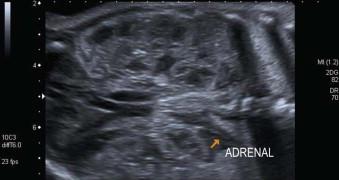
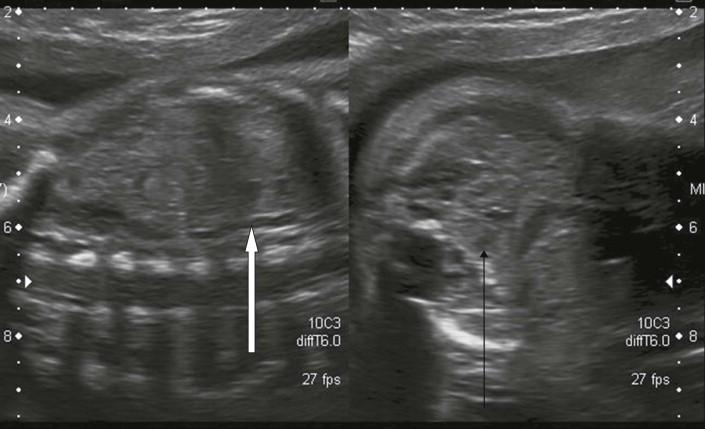
Prenatally an ectopic kidney will be pelvic in 55% of cases and is usually vizualized adjacent to the bladder and iliac wings, but the diagnosis may be subtle and quite subjective ( Figure 18-13 ). In crossed renal ectopia, most of the renal tissue lies entirely on the same side on the abdomen (with left to right ectopia more common) ( Figure 18-14 ). The ectopic kidney may be fused with the contralateral kidney but may not. An enlarged bilobed kidney will be seen on one side of the abdomen. A horseshoe kidney is best demonstrated on the coronal and transverse scans when renal tissue will be seen crossing the midline ( Figure 18-15 ).
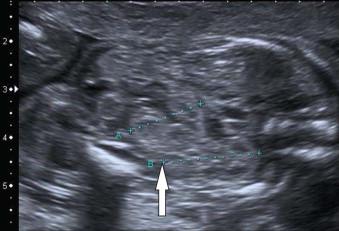
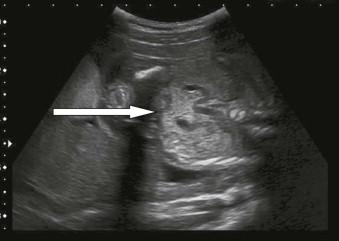
No specific obstetric complications during pregnancy and delivery are to be expected.
The pelvic kidney will have reduced function compared to the normally sited kidney as assessed by a radioisotope study at 6–8 weeks of age ( Table 18-2 ). Patients with renal ectopia are usually asymptomatic although there is an increased risk for complications such as hydronephrosis, infection and calculus formation. A pelvic kidney with no dilatation of the pelvis or ureter and a normal contralateral kidney and bladder requires a baseline radioisotope study and infrequent 2–3 yearly ultrasounds for follow-up.
| DTPA – 99m Tc-Diethylenetriamine pentaacetic acid Excreted by filtration | Dynamic renography. Assessment of renal function and drainage post frusemide |
| MAG3 – 99mTc-Mercaptoacetyltriglycerine Cleared mainly by tubular secretion |
Dynamic renography. Assessment of renal function and drainage post frusemide |
| DMSA – 99m Tc-Dimercaptosuccinic acid Absorbed by proximal renal tubules |
Static images of renal morphology and documentation of renal scarring |
| MAG3 IRC – 99mTc-Mercaptoacetyltriglycerine with indirect radioisotope cystogram |
Dynamic renography. Assessment of renal function and evaluation of reflux |
| MCUG – Micturating cystourethrography Study requires bladder catheterization, water soluble contrast and ionizing radiation. |
Imaging the bladder, urethra and evaluation of reflux |
| IVU – Intravenous urography Contrast study requiring ionizing radiation |
Imaging stones, cryptic duplex systems, horseshoe kidneys |
| MRI – Magnetic resonance imaging Cross-sectional imaging |
Imaging renal tumours |
| CT – Computed tomography Cross-sectional imaging |
Used in trauma, renal or bladder masses |
| MRU – Magnetic resonance urography | High-resolution images of parenchyma, collecting system and ureters |
Unilateral renal agenesis is found in 1 per 2000 births whereas bilateral disease is found in 1 per 5000 births.
Renal agenesis is usually an isolated sporadic abnormality but, in few cases it may be secondary to a chromosomal abnormality, part of a genetic syndrome (such as Fraser syndrome), or a developmental defect such as VACTERL (Vertebral anomalies, Anal atresia, Cardiac defects, TracheoEsophageal fistula, Renal anomalies and radial Limb abnormalities) or MURCS (MUllerian duct aplasia such as hypoplasia of the uterus, Renal aplasia, Cervicothoracic Somite dysplasia) association. In non-syndromic cases, the risk of recurrence is approximately 3%. However, in about 15% of cases, one of the parents has unilateral renal agenesis and in these families the risk of recurrence is increased.
In unilateral renal agenesis, one kidney is absent ( Figure 18-16 ). The corresponding adrenal gland takes on a globoid shape (which should not be diagnosed prenatally for a hypoplastic kidney) and also becomes more vertical in its orientation (‘the lying down’ adrenal gland) ( Figure 18-13 ). Loops of fetal bowel can occupy the renal fossa and may be interpreted as normal kidney. Compensatory hypertrophy of the contralateral kidney develops and the amniotic fluid is normal.
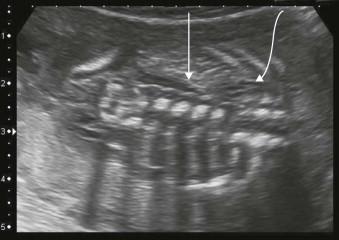
In bilateral renal agenesis both kidneys are absent and the adrenal glands assume a discoid shape and move laterally and inferiorly ( Figure 18-17 ). The bladder is absent and there is complete anhydramnios. However, the amount of amniotic fluid will be normal until the second trimester, when fetal urine becomes the main source of amniotic fluid volume. In bilateral renal agenesis and anhydramnios if any fetal detail is obtained: talipes, micrognathia and a small fetal chest will be seen. Failure to visualize the renal arteries with colour Doppler is another important clue to the diagnosis in dubious cases, both with unilateral and bilateral agenesis ( Figure 18-18 ).
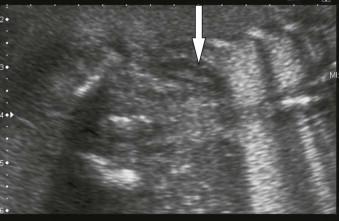
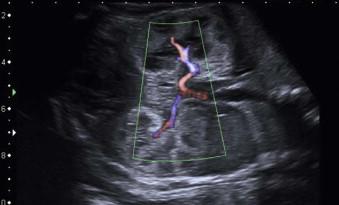
No special precautions are necessary for the fetus with unilateral renal agenesis. Bilateral renal agenesis is a lethal condition resulting in anhydramnios, severe pulmonary hypoplasia and neonatal death.
Unilateral renal agenesis may be asymptomatic and is compatible with normal lifespan. Patients with unilateral renal agenesis can have associated urological anomalies with vesico-ureteric reflux of high grade being the most common associated anomaly. Girls with unilateral renal agenesis should have a pelvic ultrasound to look for abnormalities in the Müllerian structures postnatally.
Duplex kidneys are one of the more common renal anomalies occurring in the general population with an incidence of 1 : 125 in postmortem studies. Duplex kidneys occur when the kidney is divided into two separate pelvicalyceal systems or moieties with either complete or partial duplication of the ureters. The upper pole ureter may end in the bladder or ectopically, usually into the vagina or urethra. Where it ends in the bladder it often forms a ureterocoele, which is five times more common among girls than among boys. With a ureterocoele or ectopic location there is frequently dysplasia of the upper pole. The lower pole ureter drains laterally into the trigone of the bladder and is prone to vesico-ureteric reflux.
Certain sonographic features have been described as being accurately associated with a duplex kidney including:
The presence of two separate non-communicating renal pelvices (which can be highly predictive with 93% of such cases being confirmed postnatally to have a duplex kidney) ( Figure 18-19 ).
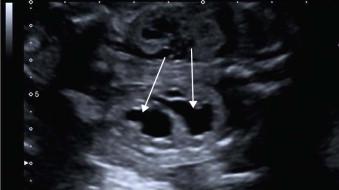
Dilated ureters ( Figure 18-20 ).
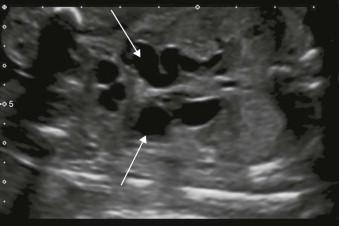
Cystic structures within one pole of the kidney; this is due either to marked hydronephrosis of the upper pole moiety and cystic change or marked distension of the calyceal system of the upper pole moiety.
Echogenic ‘cyst(s)’ of varying size in the bladder representing a ureterocoele ( Figure 18-21 ).
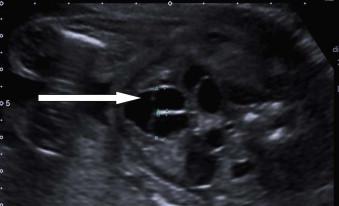
Ureterocoeles are commonly (80%) associated with a duplex kidney and consist of a cystic dilatation of the submucosal segment of the intravesical ureter with narrowing of the ureteral orifice. This stenosis will cause significant dilatation of the ectopic ureter and the upper renal moiety in 85% of cases. If the ureterocoele protrudes into the urethra or lower urinary bladder, mechanical obstruction of the bladder neck may ensue, causing bilateral hydronephrosis, which can lead to obstruction of the ipsilateral lower moiety or the contralateral kidney. It is possible to mistake a ureterocoele for an empty bladder, and also for a full bladder to efface a ureterocoele. Vesico-ureteric reflux is often seen in the lower pole moiety being present in 50% of fetuses with a ureterocoele affecting the upper pole.
The antenatal management of fetal hydro-ureteronephrosis caused by a ureterocoele is largely conservative as long as amniotic fluid volume remains normal. A large ureterocoele causing bladder outlet obstruction, progressive hydro-ureteronephrosis and oligohydramnios can be managed with fetal cystoscopy or a single percutaneous needle decompression of the bladder and ureterocoele. No specific obstetric complications during pregnancy and delivery are to be expected.
Duplex kidneys with minimal dilatation of the moieties may remain entirely asymptomatic. However, severe dilatation of either/or both moieties with dilatation of the ureter(s) with a ureterocoele and/or reflux will inevitably put the child at very high risk of urinary tract infections. These infants will require prophylactic antibiotics and radioisotope imaging at 6–8 weeks ( Table 18-2 ). Intervention is very likely when the upper moiety is associated with a ureterocoele and endoscopic puncture of the ureterocoele or upper pole nephrectomy are commonly required. Lower moiety reflux is usually treated conservatively.
Dysplastic kidneys are abnormally developed kidneys with poorly branched/differentiated nephrons and collecting ducts, increased stroma and occasionally cysts and metaplastic tissues such as cartilage.
The classic presentation of dysplastic kidneys is of large bright kidneys, with or without cystic spaces (occurring within the cortex) diagnosed after 17 weeks' gestation when the kidneys appear more echogenic than the liver or spleen ( Figure 18-22 ). Uniformly echogenic kidneys without cysts are not an uncommon finding and the difficulty lies in determining whether it is a normal variant or an indicator of significant renal disease. Dysplastic kidneys may also be small and difficult to visualize due to technical difficulties.
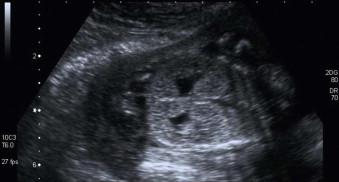
The differential diagnosis of hyperechogenic kidneys must take into account the amniotic fluid volume, the presence of associated anomalies and the family history. A list of the more common underlying pathologies is shown in Table 18-3 . Only a few of these conditions can be identified prenatally.
| Condition | Renal Size | Cysts Present | Hydro-Nephrosis | Liquor Volume | Cysts in Parents' Kidneys | Family History | Associated Findings |
|---|---|---|---|---|---|---|---|
| Autosomal recessive polycystic kidney disease | Large | No | No | Reduced | No | Yes in sibling | Hepatic fibrosis in later life |
| Autosomal dominant polycystic kidney disease | Large | Sometimes | No | Normal | Yes >20 years age | Yes in parent | Occasionally cysts in parents' liver or spleen |
| Obstructive cystic dysplasia | Small | Often | Yes | Depends on degree of renal obstruction | No | No | Hydronephrosis usually urethral obstruction |
| Finnish type nephrotic syndrome | Large | No | No | Normal | No | Yes in sibling | Raised serum AFP |
| Beckwith–Wiedemann syndrome | Large | No | No | Normal or increased | No | Occasionally | Macrosomia, hepatosplenomegaly omphalocoele, macroglossia |
| Perlman syndrome | Large | No | Some-times | Normal or increased | No | Yes in sibling | Macrosomia, hepato-splenomegaly, ascites, micrognathia, depressed nasal bridge |
| Simpson–Golabi–Behmel syndrome | Large | No | No | Normal or increased | No | Yes in sibling | Macrosomia, hepatosplenomegaly, macrocephaly, cleft lip, polydactyly, diaphragmatic hernia, cardiac defects |
| Meckel–Gruber syndrome | Large | Some times | No | Reduced | No | Yes in sibling | Polydactyly, encephalocoele |
| Trisomy 13 | Large | Sometimes | No | Normal | No | No | Facial clefting, holoprosencephaly, cardiac defects, polydactyly |
| Cytomegalovirus infection | Large | No | No | Normal | No | No | Microcephaly, hydrocephaly, intracranial calcification, large liver and spleen, hydrops |
| Renal vein thrombosis | Large – usually unilateral | No | No | Normal | No | No | Maternal diabetes, maternal pyelonephritis |
| Normal | Normal | No | No | Normal | No | No |
No single ultrasonographic criterion is specific of aetiology and the degree of hyperechogenicity has no value in establishing the aetiology. Fetal kidneys must be measured and compared with reference tables and corticomedullary differentiation, presence and characteristics of any cysts (size, location, number) and amniotic fluid volume must be analyzed. Attention should be paid to hands and feet, thorax, spine and posterior fossa. Karyotyping should be discussed, particularly if other malformations are detected. If the kidneys and all measurements lie above the 95th percentile then an overgrowth syndrome, such as Beckwith–Wiedeman, Perlman or Simpson–Golabi–Behmel should be considered. If the bladder is enlarged, with or without dilated ureters, then the findings reflect an obstructive uropathy.
If following these investigations, it appears that the fetus has isolated hyperechogenic kidneys with no evidence of renal tract obstruction, then the aetiology lies between:
renal dysplasia;
autosomal recessive polycystic kidney disease;
autosomal dominant polycystic kidney disease;
nephrocalcinosis;
a variant of normal, especially when the amniotic fluid volume remains normal.
A detailed family history and ultrasound examination of the parents' kidneys may help in identifying the underlying cause.
No specific obstetric complications during pregnancy and delivery are to be expected. The outcome of dysplastic kidneys depends on the underlying pathophysiology and the presence of other structural defects or genetic conditions. Outcome of isolated dysplastic kidneys depends on whether they are unilateral or bilateral. Bilateral disease has poor prognosis as it is associated with oligohydramnios and likely early neonatal death due to lung hypoplasia. In these cases, termination of pregnancy can be considered. If abnormalities are severe and parents elect for termination, or there is a perinatal death, it is vitally important to arrange an expert postmortem examination with tissue for histology and DNA storage. Increased renal echogenicity even with normal amniotic fluid in a fetus without other anomalies may be indicative of a parenchymal anomaly with the possibility of renal failure after birth or in early childhood, and therefore further follow-up will be required.
In the majority of cases definitive diagnosis of hyperechogenic kidneys depends on postnatal investigations. Early serial estimation of urea electrolytes and creatinine will provide a reasonable estimation of overall renal function. If the renal function is normal or a little reduced, radioisotope imaging will clarify the degree of functioning renal tissue in each kidney. Long-term monitoring of renal function and blood pressure is mandatory.
Multicystic dysplastic kidney (MCDK) disease is thought to be the consequence of either developmental failure of the mesonephric blastema to form nephrons or early obstruction due to urethral or ureteric atresia. The collecting tubules become cystic and the diameter of the cysts determines the size of the kidneys, which may be enlarged or small. MCDKs are classically associated with non-patent ureters and obstruction, perhaps reflecting improper ureteric canalization around 8 weeks. The prevalence of MCDK is approximately 1 in 1000–5000 births and in 80% of cases is unilateral. Unilateral MCDK is more common in males and the left side is more commonly affected than the right. A positive family history is rare, since there is only a small risk of recurrence.
MCDKs have characteristic appearances:
Multiple thin-walled cysts, which do not connect to each other or to the rest of the urinary tract and are distributed randomly throughout the kidney ( Figure 18-23 ).
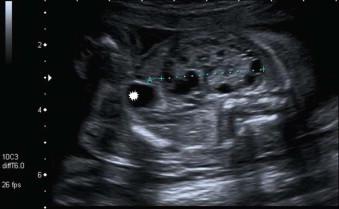
Renal enlargement with an irregular non-uniform outline.
A renal pelvis or ureter cannot be demonstrated.
Parenchymal tissue between the cysts is often hyperechogenic ( Figure 18-24 ).
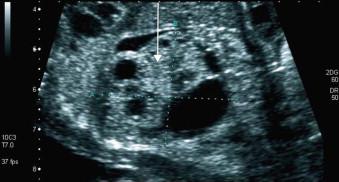
Renal arterial flow may not be detectable using colour Doppler.
The lack of renal artery, vein, ureter or cysts in some cases of multicystic dysplastic kidneys suggest that renal agenesis and dysplastic kidney may be opposite ends of a spectrum of renal malformation. This is further supported by the finding that, in about 15% of cases with multicystic dysplastic kidneys, there is a contralateral renal agenesis ( Figure 18-25 ). In the unilateral form, liquor volume is usually normal but there is likely to be oligo- or anhydramnios with bilateral disease. The macrocystic lesions of the MCDK are easy to distinguish from polycystic kidney disease, which presents antenatally as enlarged hyperechoic kidneys with microscopic cysts filling the renal parenchyma. In the majority of cases, MCDK is a sporadic, isolated defect not associated with chromosomal abnormalities. In a study of 102 cases with MCDK, 9.8% of cases had an abnormal karyotype but in all cases there were extra-renal anomalies present. Detailed examination of the other kidney is essential in unilateral presentations, since 25% of kidneys contralateral to MCDK are either structurally abnormal (duplex system, pelvico-ureteric obstruction, agenesis or ectopic) or affected by vesico-ureteric reflux.
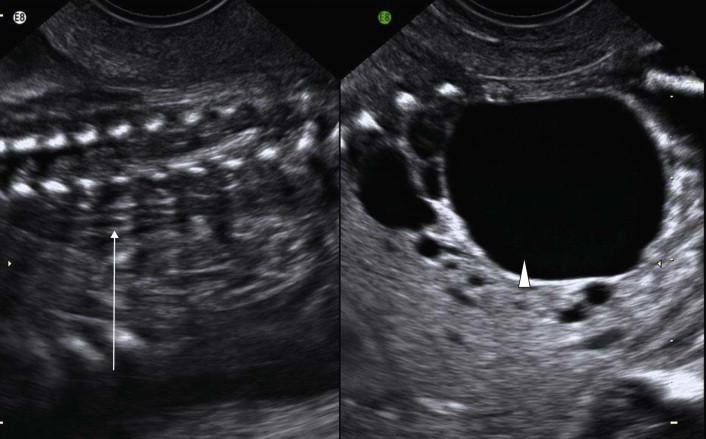
Unilateral forms have a good prognosis whereas bilateral disease is lethal due to anhydramnios and pulmonary hypoplasia. The cyst size usually increases throughout fetal life, and extremely rarely, large cysts may expand the fetal abdomen or cause dystocia and therefore might require intrauterine drainage. No specific obstetric complications during pregnancy and delivery are to be expected.
Spontaneous resolution of the multicystic kidney is usual during postnatal life. By five years of age 50% of such kidneys will have involuted and will no longer be vizualized sonographically. Initial management is conservative and nephrectomy is indicated in a very small number of kidneys which are large from the outset, increase in size or show no evidence of involution. Nephrectomy is also recommended when the MCDK is associated with an ipsilateral dilated ureter with or without reflux or a ureterocoele. All abnormalities of the contralateral functioning kidney will require early investigation to minimize any risk of damage to the solitary functioning kidney.
Autosomal recessive polycystic kidney disease (ARPKD) is an inherited condition also referred to as infantile polycystic kidney disease. The enlarged kidneys are filled with numerous cysts (<4 mm) radiating from the medulla to the cortex and dilated collecting ducts. The disease has a wide spectrum of renal and liver involvement and is subdivided into perinatal (most common), neonatal, infantile and juvenile types on the basis of the age of onset of the clinical presentation and the degree of renal tubular involvement. The more severe the renal disease the less severe is the hepatic fibrosis. The prevalence of infantile polycystic kidney disease is about 1 in 30,000 births. It is an autosomal recessive condition with a 25% risk of recurrence. The responsible gene is located in the short arm of chromosome 6 and prenatal diagnosis in the first trimester is available in affected families (reliable prenatal diagnosis in 80% of affected families).
In utero, the expression of the disease is variable.
In the prenatal subtype:
Bilateral renal enlargement well above the 90th percentile for length and width.
The renal parenchyma is very echogenic, particularly in the medullary areas ( Figure 18-26 ).
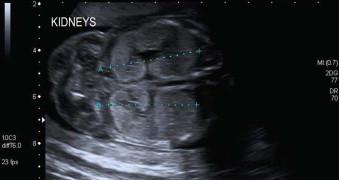
No cysts are visible in most cases and the cortex may be less echogenic.
Absence of normal corticomedullary differentiation ( Figure 18-27 ).
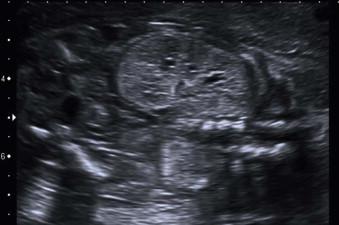
Increased abdominal circumference measurement due to massive kidney enlargement ( Figure 18-28 ).
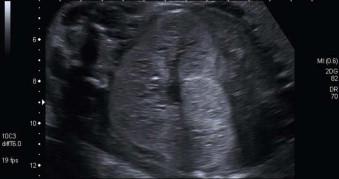
The bladder size is small but some urine will be present at least initially ( Figure 18-29 ).
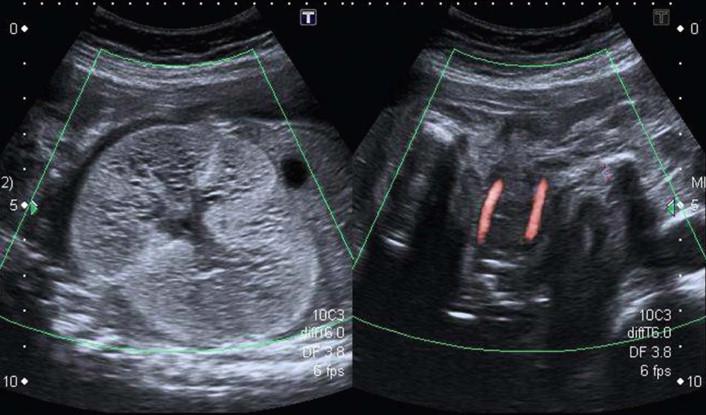
Gradual onset of oligohydramnios with progressive reduction in the amniotic fluid volume from the second trimester.
The liver appearances are normal, despite the presence of cysts, portal fibrosis and proliferation of bile ducts. However, the sonographic appearances may not become apparent before 24 weeks of gestation and therefore, serial scans should be performed for exclusion of the diagnosis. The differential diagnosis includes Meckel–Gruber syndrome (polydactyly and encephalocoele), trisomy 13 (other abnormalities such as holoprosencepahly, polydactyly, cleft lip/palate, and fetal growth restriction will be seen), Beckwith–Wiedemann or Perlman syndrome (macrosomia will be present and amniotic fluid is normal), adult dominant polycystic kidney (identical sonographic appearance to ARPKD but there is positive family history) ( Table 18-3 ). Some fetuses remain sonographically normal and in these, kidney enlargement will develop only in infancy and renal failure is anticipated to occur relatively late during the second decade of life.
Become a Clinical Tree membership for Full access and enjoy Unlimited articles
If you are a member. Log in here